Not sure what your skin type is? Don’t worry, you’re not alone! Understanding your skin is crucial for building a skincare routine that actually works. Knowing whether your skin is dry, oily, combination, or sensitive helps you choose the right products and avoid those that can cause irritation. Identifying your skin type is the first step to establishing a successful skincare routine. This guide will help you figure out your skin type and provide tips to keep it healthy. Ready to unlock your best skin?
Let’s get started!
Determining your skin type can be simple and effective. Follow these steps to test your skin:
- Cleanse your face: Start with a gentle, fragrance-free cleanser to remove any makeup, dirt, and oil.
- Pat dry: Gently pat your face dry with a clean towel or tissue. Make sure not to apply any products afterward.
- Wait: Leave your skin alone for two hours. During this time, do not use any products like moisturizers, toners, or serums. This allows your skin to show its natural state.
- Observe your skin: After two hours, take note of how your skin feels and looks:
- Dry skin: If your skin feels tight, flaky, or appears dull, you likely have dry skin.
- Oily skin: If you notice a shiny appearance all over your face, you probably have oily skin.
- Combination skin: If only your T-zone (forehead, nose, chin) feels oily while your cheeks are normal or dry, you have combination skin.
- Normal skin: If your skin looks balanced and healthy without excess oil or dryness, you likely have normal skin.
- Sensitive skin: Also pay attention to any redness, itching, or irritation, which can indicate sensitive skin.

Can your skin type change?
Yes, your skin type can change over time due to factors like age, hormonal fluctuations, and environmental conditions. For example, as you age, your skin may become drier due to reduced oil and collagen production. Seasonal changes also play a role; cold weather can lead to dryness, requiring the need for thicker creams in winter, while humidity can cause oiliness in summer. Additionally, lifestyle factors such as diet, hydration, and stress can impact your skin’s condition. Regularly assessing your skin and adjusting your skincare routine is key to maintaining healthy skin.
Skincare tips for each skin type
Now that you’ve identified your skin type, it’s time to tailor your skincare routine to meet your skin’s unique needs. Here are essential tips for each skin type:
Normal skin
If you have normal skin, you're in luck! Your skin is balanced, with few issues.
Skincare tips:
- Cleansers: Use a gentle cleanser to maintain your skin's balance.
- Moisturizers: A lightweight moisturizer will keep your skin hydrated without feeling heavy.
- Sunscreen: Always apply broad-spectrum SPF daily to protect against UV damage.
Dry skin
If your skin feels tight or flaky, it’s crucial to focus on hydration.
Skincare tips:
- Cleansers: Choose a creamy or hydrating cleanser to avoid stripping natural oils.
- Moisturizers: Look for rich creams containing hyaluronic acid, glycerin, or ceramides to lock in moisture.
- Exfoliation: Use a gentle exfoliant to remove dead skin cells, but limit this to 1-2 times a week to avoid irritation.
Oily skin
If your skin is shiny and prone to breakouts, it's essential to control excess oil.
Skincare tips:
- Cleansers: Use a foaming or gel cleanser with salicylic acid to help unclog pores.
- Moisturizers: Opt for oil-free, non-comedogenic moisturizers that won’t clog your pores.
- Exfoliation: Regular exfoliation with a BHA (like salicylic acid) can help keep your pores clear.
Combination skin
If you have combination skin, your routine should address both oily and dry areas.
Skincare tips:
- Cleansers: A gentle gel cleanser works well to cleanse without over-drying.
- Moisturizers: Consider using different moisturizers for different areas; a lightweight gel for the T-zone and a richer cream for the cheeks.
- Exfoliation: Focus on balancing; gentle exfoliation 1-2 times a week can help manage the oily T-zone.
Sensitive skin
If your skin is prone to redness and irritation, it requires extra care.
Skincare tips:
- Cleansers: Use a mild, fragrance-free cleanser to avoid irritation.
- Moisturizers: Look for soothing ingredients.
- Patch test: Always patch test new products on a small area of skin to avoid adverse reactions.
Common mistakes to avoid for each skin type
Understanding your skin type is only the beginning; avoiding common pitfalls is essential for maintaining healthy skin. Here are some mistakes to watch out for based on your skin type:
Normal skin
-
Mistake: Overcomplicating your routine.
- Tip: Stick to a simple regimen. Adding too many products can lead to irritation and imbalance.
Dry skin
-
Mistake: Using harsh cleansers.
- Tip: Avoid cleansers with sulfates or strong astringents that can strip away natural moisture.
-
Mistake: Skipping moisturizer.
- Tip: Always moisturize, even if your skin feels okay. Hydration is key to preventing dryness.
Oily skin
-
Mistake: Over-cleansing or scrubbing too hard.
- Tip: Excessive cleansing can lead to increased oil production. Use gentle products and limit cleansing to twice a day.
-
Mistake: Avoiding moisturizers altogether.
- Tip: Oily skin still needs hydration. Choose lightweight, oil-free moisturizers.
Sensitive skin
-
Mistake: Trying too many new products at once.
- Tip: Introduce new products gradually to pinpoint any irritants. Stick to gentle, tested formulations. Always check for potential irritants or allergens in your products!
Your skin journey awaits!
You’ve taken an important step in understanding your skin! Knowing your skin type empowers you to choose the right products and tailor your routine for the best results. Remember, skincare is a journey, don’t hesitate to experiment and adapt as your skin changes. If you have significant concerns, like chronic acne or irritation, seeking professional help from a dermatologist is crucial. Stay curious, keep learning, and enjoy pampering your skin! Here’s to healthier, happier skin!





0 comments